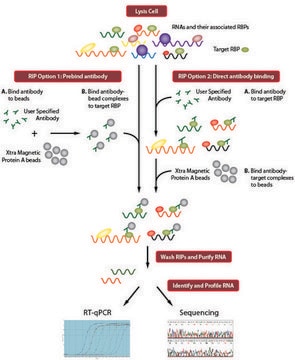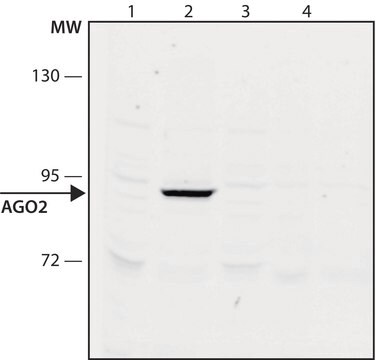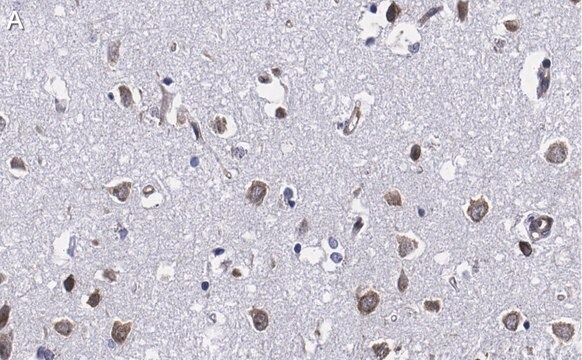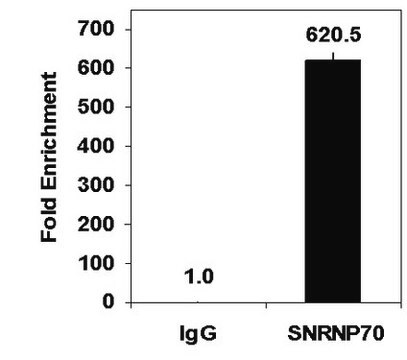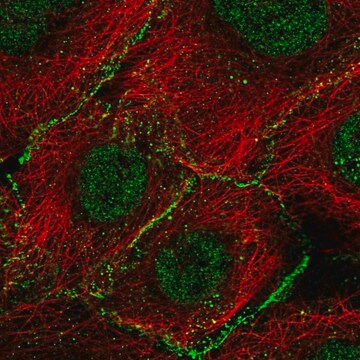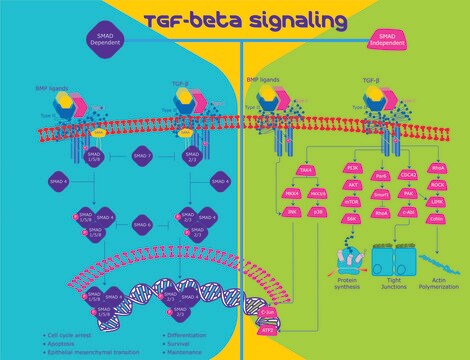04-642
Anti-Ago2 Antibody, clone 9E8.2
ascites fluid, clone 9E8.2, Upstate®
Synonym(s):
Argonaute-2, Eukaryotic translation initiation factor 2C, AGO2, eIF-2C, Slicer protein, MGC3183, Piwi domain protein, PPD
Sign Into View Organizational & Contract Pricing
Select a Size
All Photos(1)
Select a Size
Change View
About This Item
UNSPSC Code:
12352203
eCl@ss:
32160702
NACRES:
NA.41
Recommended Products
General description
Ago2 (argonaute-2), also known as eukaryotic translation initiation factor 2C (EIF2C2), is an essential component for siRNA-directed RNA interference (RNAi) response. Ago2 is an endonuclease required for the unwinding of siRNA duplex and assembly of siRNA into RNA-induced silencing complexes (RISC). Ago2 interacts with DICER1 through its Piwi domain. This Piwi domain is thought to provide RNA cleavage activity via a mechanism similar to RNase H. Ago2 activity is necessary for embryonic development as well as RNA-mediated gene silencing (RNAi).
Specificity
human Ago2
Immunogen
Epitope: near the N-terminus of Ago2
KLH-conjugated, synthetic peptide containing the sequence YSGAGPALAPPAPPPPIQG
Application
Anti-Ago2 Antibody, clone 9E8.2 is a Mouse Monoclonal Antibody for detection of Ago2 also known as Argonaute-2, Eukaryotic translation initiation factor 2C & has been validated in WB and has been demonstrated to perform in ChIP and ChIP-seq.
ChIP and ChIP-seq: A representative lot of this antibody was used to perform ChIP and ChIP-seq ( Woolnough, JL, Atwood, BL, and Giles KE (2015), MCB Vol. 35 No. 13, p. 2278-2294).
Research Category
Epigenetics & Nuclear Function
Epigenetics & Nuclear Function
Research Sub Category
RNA Metabolism & Binding Proteins
Chromatin Biology
RNA Binding Protein (RBP)
RNA Metabolism & Binding Proteins
Chromatin Biology
RNA Binding Protein (RBP)
Quality
Routinely evaluated by immunoblot.
Target description
~100 kda
Physical form
Ascites with 0.05% sodium azide
ImmunoAffinity Purified
Storage and Stability
Stable for 1 year at -20°C from date of receipt.
Handling Recommendations: Upon receipt, and prior to removing the cap, centrifuge the vial and gently mix the solution. Aliquot into microcentrifuge tubes and store at -20°C. Avoid repeated freeze/thaw cycles, which may damage IgG and affect product performance
Handling Recommendations: Upon receipt, and prior to removing the cap, centrifuge the vial and gently mix the solution. Aliquot into microcentrifuge tubes and store at -20°C. Avoid repeated freeze/thaw cycles, which may damage IgG and affect product performance
Legal Information
UPSTATE is a registered trademark of Merck KGaA, Darmstadt, Germany
Disclaimer
Unless otherwise stated in our catalog or other company documentation accompanying the product(s), our products are intended for research use only and are not to be used for any other purpose, which includes but is not limited to, unauthorized commercial uses, in vitro diagnostic uses, ex vivo or in vivo therapeutic uses or any type of consumption or application to humans or animals.
Not finding the right product?
Try our Product Selector Tool.
recommended
Product No.
Description
Pricing
Storage Class Code
12 - Non Combustible Liquids
WGK
nwg
Flash Point(F)
Not applicable
Flash Point(C)
Not applicable
Certificates of Analysis (COA)
Search for Certificates of Analysis (COA) by entering the products Lot/Batch Number. Lot and Batch Numbers can be found on a product’s label following the words ‘Lot’ or ‘Batch’.
Already Own This Product?
Find documentation for the products that you have recently purchased in the Document Library.
Differential expression of microRNA expression in tamoxifen-sensitive MCF-7 versus tamoxifen-resistant LY2 human breast cancer cells.
Manavalan, TT; Teng, Y; Appana, SN; Datta, S; Kalbfleisch, TS; Li, Y; Klinge, CM
Cancer letters null
Keriayn N Smith et al.
Stem cell reports, 9(1), 108-121 (2017-06-06)
Of the thousands of long noncoding RNAs expressed in embryonic stem cells (ESCs), few have known roles and fewer have been functionally implicated in the regulation of self-renewal and pluripotency, or the reprogramming of somatic cells to the pluripotent state.
Li Zhang et al.
Cell death & disease, 10(3), 168-168 (2019-02-20)
Cholestasis induces the hepatic long non-coding RNA H19, which promotes the progression of cholestatic liver fibrosis. However, microRNAs that are dysregulated by H19 during cholestasis remain elusive. Using miRNA-sequencing analysis followed by qPCR validation, we identified marked upregulation of eight
Israel Pichardo-Casas et al.
Brain research, 1436, 20-33 (2011-12-27)
In recent years, microRNAs or miRNAs have been proposed to target neuronal mRNAs localized near the synapse, exerting a pivotal role in modulating local protein synthesis, and presumably affecting adaptive mechanisms such as synaptic plasticity. In the present study we
Maximilian Rentschler et al.
Cellular physiology and biochemistry : international journal of experimental cellular physiology, biochemistry, and pharmacology, 51(3), 1103-1118 (2018-11-27)
Cellular senescence, or permanent growth arrest, is known as an effective tumor suppressor mechanism that can be induced by different stressors, such as oncogenes, chemotherapeutics or cytokine cocktails. Previous studies demonstrated that the growth-repressing state of oncogene-induced senescent cells depends
Our team of scientists has experience in all areas of research including Life Science, Material Science, Chemical Synthesis, Chromatography, Analytical and many others.
Contact Technical Service
